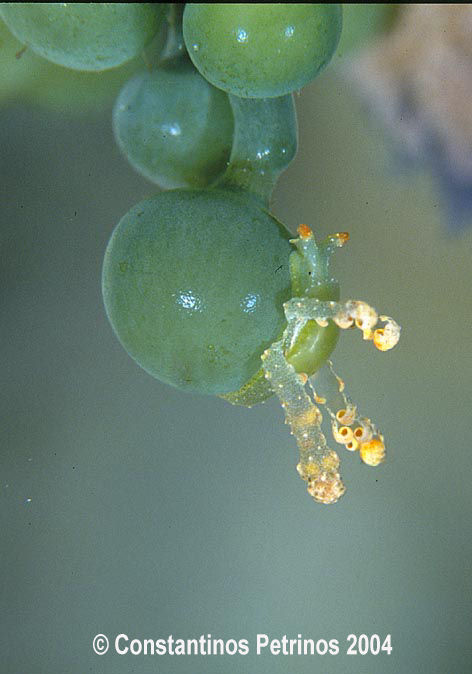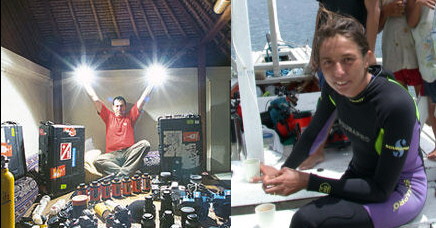 |
Lobiger viridis
Photo courtesy of Constantinos Petrinos and Carine SchrursPhoto taken at Anilao Philippines in May of 2003
Lobiger viridis Pease, 1863
Lobiger is one of the fascinating species of sacoglossa that has retained the typical spiral gastropod shell. Lobiger's belong to the family, Oxynoidae.
L. viridis is characterized by four long parapodial extensions or flaps which when unrolled display bright patches of color, clearly visible in Con's photo here. In L. viridis these flaps can be quite long in some specimens. The Caribbean species, L. souverbii ,(Bill Rudman's Sea Slug Forum) differs from Indo-West Pacific animals in having crenulations or little bumps, along the edge of these flaps rather than the larger branch-like extensions.
All the species can be found crawling on their green algal food, Caulerpa . A warning however, this is a very cryptic species, and depending on the size of the animal and the species of Caulerpa you are looking on, it is nearly invisible. Con's photo here is fairly atypical, his animal hanging off for all the world to see. Oh yes, did I mention that they are also tiny, note the size of the specimen shown here on the grape-like lobe of Caulerpa which is only about 3 mm in diameter. Large specimens can reach about 25mm, however.
The parapodial flaps appear to have several defensive functions. First when they are unrolled exposing their bright tips, they make the critter look over twice its size, and indeed aposomatic. Secondly the flaps can be cast off, or autotomized, when disturbed by a predator. When this happens they wiggle off in the water, like the tail separated from a lizard. The movement is thought to draw the predator's attention away from the slug.
Unrolling the parapodia may function also to expose the body tissue which contains photosynthetically active chloroplasts to greater sunlight. The increased light would increase the production of chemical byproducts from these algal cell organelles, which serves as a secondary source of nutrition to the slug.
L. viridis occurs throughout the Tropical Indo-Pacific. The Caribbean species, L. souverbii, has also been reported from the tropical eastern Pacific, both from Bahia de Bandera , Nayarit, Mexico and from Costa Rica .
Danville, Calif
Feb. 2004
Constantinos Petrinos and Carine Schrurs

Other than snorkeling, Carine Schrurs , had no great interest in diving until she started sailing and crossed the Atlantic. After watching the dolphins in the Azores and snorkeling with sea lions in the Galapagos, she decided that it would be nice to follow them past her free diving capabilities. Upon her return to Europe, Carine became a PADI instructor and set off to dive the world oceans. Most of her underwater photography was done in Spain, Indonesia, Philippines, Thailand, Maldives and the Caribbean. Carine is currently working with Constantinos Petrinos on a book project about the biology and behavior of nudibranchs with marine biologist, David W. Behrens. |
Constantinos's photographs have won awards at many competitions, including the BBC Wildlife Photographer of the Year. His articles and photos have appeared in various magazines, such as BBC Wildlife, Tauchen, Der Spiegel, Duiken, Dive, Oceans Illustrated, Skin Diver, Scuba Diver Australasia and the Greek editions of National Geographic and National Geographic Traveller. He is the photographer on location for the Hellenic Institute of Marine Archaeology, which conducts underwater excavations in conjunction with the Greek Ministry of Culture. Constantinos is the underwater photography expert for the Nikon Owners Club International. Throughout the year, Constantinos conducts slide shows in Greek schools, to promote marine awareness. He is a Fellow of the Royal Photographic Society.
Constantinos prefers to stay on location for a minimum of two months when working on major projects. He believes that you need to spend many hours underwater to familiarise yourself with the particular habitat and the species present in order to be able to capture behavioural scenes on film. For his book, Realm of the Pygmy Seahorse , he spent five months in Sulawesi and took 25,000 slides.
Send Contantinos mail at petrinos@otenet.gr
or visit his Web Site .
WEBMASTER'S NOTES: As has been indicated in past BOW's, taking quality branch shots is no slam dunk! Without going into details, you can be assured that Contantinos and Carine had to work long and hard to get the above shot! Just about all the skills applied in other aspects of underwater photography also apply in the photography of sea slugs. Composition, lighting, focus, etc all come together for that prize winning shot. Think about it next time you encounter one of our slug friends!
Taxonomic information courtesy of:

David W. Behrens
Author:
Pacific Coast Nudibranchs
Send Dave mail at dave@seachallengers.com
|
